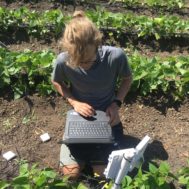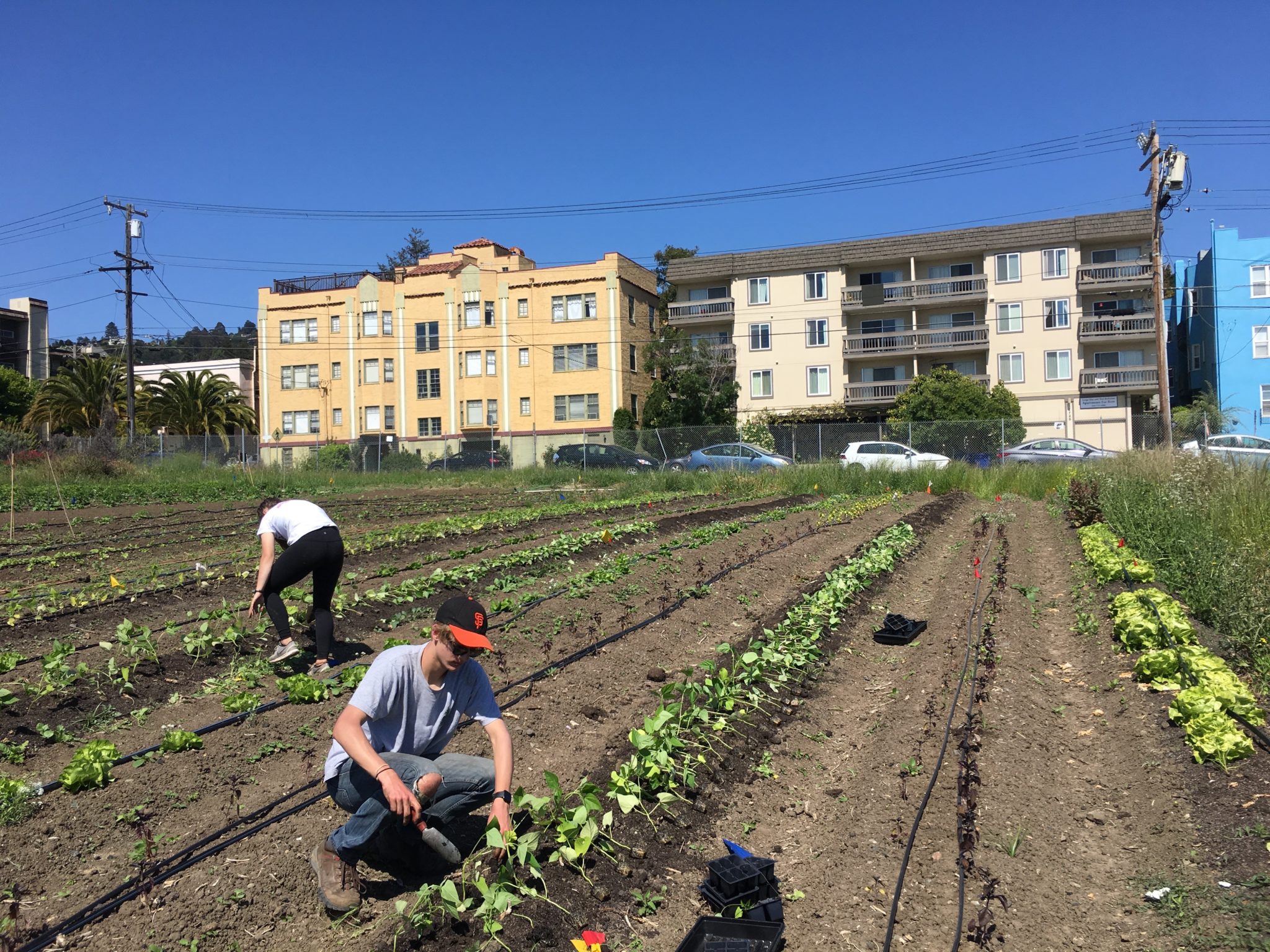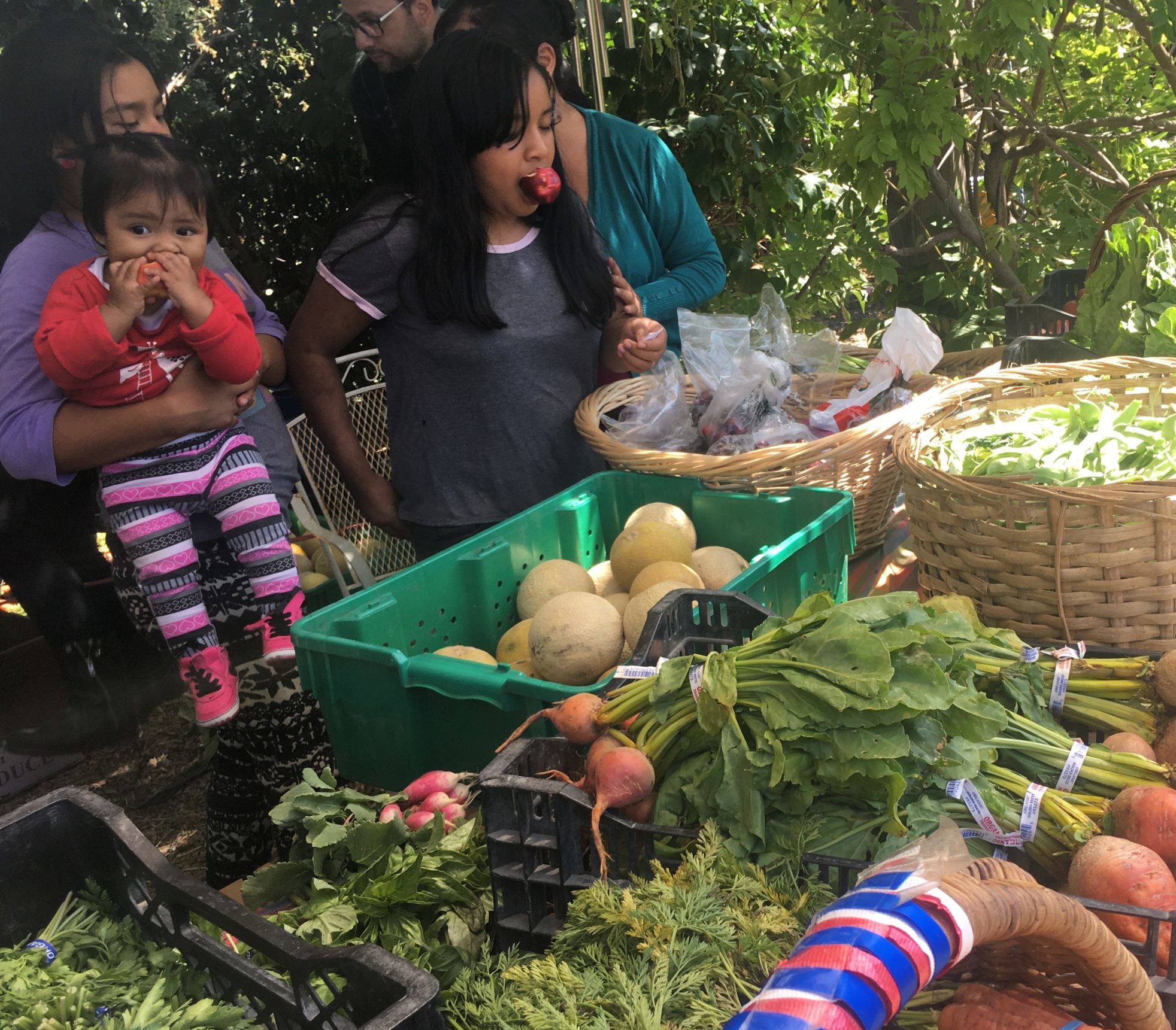
Milton Stookey
September 30, 2020
By Milton Stookey
Milton Stookey is a third-year undergraduate studying physics at U.C. Berkeley.
Downtown Berkeley might seem like an unusual place for a farm. Yet in the middle of multi-level apartments and high-end restaurants, UC Berkeley students have the opportunity to work on a quarter-acre no-till farm, engage in agroecological research, and feed food-insecure neighbors.
Working the Soil and Water
I enjoyed taking part in these efforts as part of an interdisciplinary project generously funded by the Foundation for Farm and Agricultural Research. Since 2017, this has brought together ecologists, city planners, urban farmers, food banks, local nonprofits, low-income residents, educators, and policymakers to better understand the social and ecological dimensions of urban food production. Researchers leading this project at UC Berkeley have worked to document transformative solutions both to improve the ecological sustainability of urban farming systems, and to understand the capacity of urban farms to provide local, nutrient-dense foods to low-income populations.
My role in this project is situated within the Berkeley Agroecology Lab, where I work as a research assistant. Though I’ve recently spent more time indoors, I still love to work at the Oxford Tract—a space near downtown Berkeley for research and experiential learning—whenever I can. In the lab, my main focus is studying how intensively managed no-till agriculture influences soil hydraulic properties, which influence how soil stores water and makes it available for plants. “No-till” agriculture can include a wide range of practices depending on the size, finances, and goals of a particular farm, but generally describes a management ethos that minimizes disturbance of the soil. This often means limiting the use of plows or tractors to mechanically break up the soil, and instead utilizing living roots to maintain soil porosity, aeration, and structure.
This type of management has huge implications for water use and agriculture. When soils are broken apart, it can lead to short-term boosts in productivity, but longer-term losses in nutrients, water, carbon, and topsoil. Water resources in California are scarce, and the increasing threat of climate change and severe drought requires that farmers innovate to ensure the resilience and viability of their crops. What’s more, urban and rural farmers face distinct challenges in getting access to water. Water rates in cities tend to be higher than subsidized irrigation districts in rural areas. Thus, exploring soil management solutions that help both urban and rural farmers reduce water inputs can help them survive in their own context and respond to their unique risks.
Through my work in the Agroecology Lab, I have nearly completed water retention-based analyses for all of our experimental plots, allowing us to compare soil water storage, plant available water, and other properties across our different agricultural management systems. Over the summer, I also set up a network of soil moisture sensors to continuously log data over the course of a drought simulation, where we intentionally reduced irrigation to crops to see how different soil management practices affect their responses to potential future climate scenarios. These measurements will help us evaluate whether minimizing soil disturbance might be a method for California farmers to help extend their water reserves and improve their farms’ resilience.

Students working in the Oxford Tract.
Water is just one facet of the project, however. As the scientific dimension of agroecology aims to be a holistic framework for studying agroecosystems, our team investigates many aspects of the dynamic and living systems that compose soil. These include soil carbon fractions, colonization of plant roots by fungal symbionts, and soil microbial activity, all of which are important markers of soil health. Preliminary findings point towards significant changes in the form and function of soil ecosystems under no-till management.
One example is microbial enzyme activity. After just two years of no-till management, our measurements indicate that limiting soil disturbance can dramatically increase enzymatic activity and shift this activity onto smaller soil particles called clays. This has implications for how soil may be stored on mineral surfaces and stabilized on long time scales, a critical component of capturing atmospheric carbon for climate change mitigation. Another remarkable finding was the dramatic shifts in fungal community structure under no-till management. By targeting, amplifying, and “sequencing” a specific region of the fungal genome sampled from our soil, we are able to reconstruct the different fungal species that persist across our model farm. Surprisingly, no-till treatment seems to give competitive advantage to saprotrophs, fungal species that decompose dead matter. We are exploring how shifting fungal populations may contribute to the health of food crops that co-exist with these fungal species.
Feeding Our Neighbors
What makes this project particularly inspiring to me is its commitment to serving those in our immediate community. This exemplifies that another foundational aspect of agroecology: its role in social movements, and in enacting social change. Every season, our no-till farm produces around 3,000 pounds of produce, and donates it to food banks, churches, and other food distribution hubs. It is grounding and immensely gratifying to participate in this effort.

Crates of harvested vegetables.
We began this project wondering what the capacity of small farms is to meet the food needs of our communities. Can small, urban farms help address food insecurity amongst local low-income populations? Through a combination of surveys, interviews, and food mapping, we began to answer these broad questions. For example, we estimate that our model farm was able to supply fresh vegetables to approximately 150-180 low-income or food insecure households a week. By evaluating the nutritional content of the food that we grow, we can track exactly what nutritional support we are providing those households.
Urban agroecology can be more than a supplementary means of growing food, however. It can be a much-needed catalyst for environmental and social change. By involving local city-dwellers with the process of growing their own food, we can reconnect cities to nature, and encourage people to think more directly about environmental crises. By growing food locally, we can reduce the carbon footprint of agriculture by eliminating long-distance transportation and refrigeration needs. Finally, by collectively pitching in to grow and share food, we can build stronger, more interconnected communities.
Food has an enormous power to bring people together. Just like dance and music, food is something fundamental to all human experience. It’s a source of pride, joy, creativity, and humanity, and it has an extraordinary capacity to drive good.